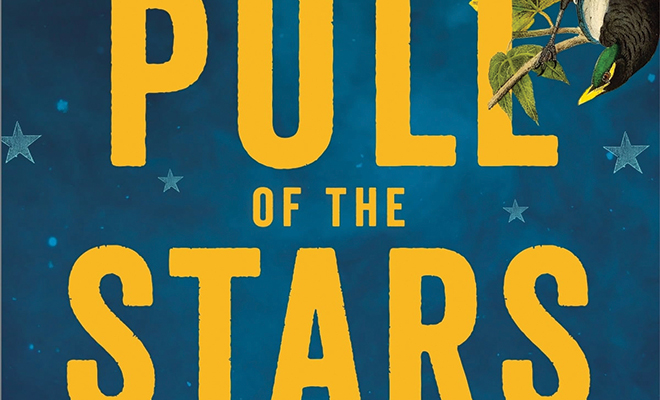
The Pull of The Stars by Emma Donoghue
The Pull of the Stars by Emma Donoghue is a novel about three horrendous days in the life of a maternity ward nurse in Dublin during the flu pandemic of 1918. The pull of the stars refers to the Italian phrase “influenza delle stelle,” the influence of the stars.
Medieval Italians believed that our illnesses were governed by the heavens. Before you decide that you are totally uninterested in this type of novel, let me assure you that the novel will surprise you as it slowly pulls you into the world of the Spanish flu and early maternity ward nurses who were trying to care for their patients using the latest techniques of the day.
Nurse Julia Power is left in charge of the maternity ward with three patients who have the flu when her supervisor, Matron, falls ill with the flu. Nurse Power is a well-trained nurse; she has three diplomas—one from a technical school, one from the hospital and one in her area of specialty, midwifery. She should be able to cope, and however temporary, acting ward nurse is a good promotion. Yet as one crisis after another assails her, she pleads for help only to be told there is none, and she’s asked, “You only have three patients?”
Nevertheless, Nurse Power is sent a young girl, a runner, who is straight off the streets, or so it appears, untrained and uneducated. Bridie Sweeney assures Nurse Power that yes, she has had the flu. Bridie proves to be a life-saver as she runs errands and helps Nurse Power with innumerable gross and demeaning tasks needed to care for their patients who struggle with childbirth while suffering the ravages of the Spanish flu.
As the day progresses, Bridie shares a little of her life with Nurse Power, revealing that she lives in a home for the unadopted children of unwed mothers. The humiliating details reveal the wretched lives of these women and their children in Catholic Ireland. Nurse Power is shocked at the unchristian attitude of the sisters and priests. She believes that Bridie, uneducated though she is, has great potential as a future nurse.
Bridie provides the only comic relief in the novel. Bridie’s naiveté and her street smarts are a perfect foil for the rigid structure of hospitals. Her innocent-seeming misdirection of the coppers when they come to arrest Dr. Lynn is priceless.
An orderly, Groyne, is particularly dislikeable character. He constantly gets on everyone’s nerves with his off-tune singing and his laconic euphemisms for those who died. He constantly talks down to the nurses because he can’t accept any woman “set over him.”
Yet it’s Groyne who informs Nurse Power that Dr. Lynn, the rebel doctor, has arrived on the maternity ward to help out. Because of the Great War, doctors were scarce, so the hospital was happy to receive Dr. Lynn even if she was a rebel and a woman. Since Dr. Lynn is a general doctor, Nurse Power is at first skeptical of her training in obstetrics.
Dr. Lynn proves to be exactly what is needed in this crisis; she’s cool and calm with a no-nonsense attitude. In a shocking breach of protocol, Dr. Lynn authorizes Nurse Power to give her patients whiskey, chloroform or morphine as needed. “You seem awfully capable,” she says. The strain of covering too many wards with too few doctors called for old rules to be broken and new ones established.
In the words of the author, The Pull of the Stars is a work of fiction held together by facts. Dr. Kathleen Lynn was a doctor who was vice president of Sinn Féin executive and its director of public health. She worked for many years as a tireless advocate of public health issues including nutrition, housing and sanitation.
The novel tells the story of Dublin during the worst of the Spanish flu pandemic that killed more than 50 million people worldwide during 1918 and 1919, according to The Centers for Disease Control. The influenza viruses were not discovered until the invention of the electron microscope in 1933, and the first influenza vaccine was developed in 1938. Donoghue wrote her book before the COVID-19 pandemic began and delivered her final draft in March 2020 just as the pandemic began in earnest.
The parallels between the two events are eerily similar. Doctors and nurses are overwhelmed by an enemy they have never met before. The medical workers are pushed to exhaustion. Barely trained medical workers are pressed into service because no one else was available. Hospitals are overflowing with patients. Mortality is extremely high. Fear of catching the disease is everywhere, and no one knows how to avoid it.
This is not a romantic novel for a cozy weekend, but I believe it will draw you into the story and demonstrate how, once again, history repeats itself.







